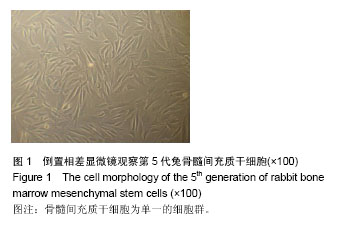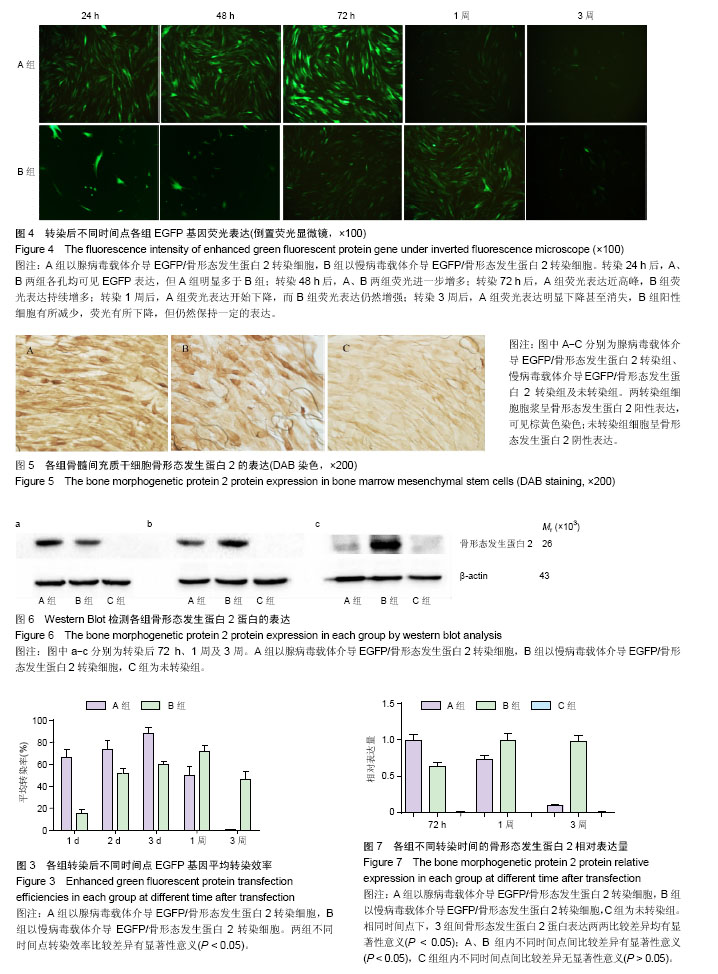| [1] Xu Feng,Zhan YL,Song XH,et al.Research Progress of BMP-2 Gene Therapy for Bone Defect.Medical Recapitulate. 2012;11(18):1612.[2] Lebouvier A,Poignard A,Cavet M,et al.Development of a simple procedure for the treatment of femoral head osteonecrosis with intra-osseous injection of bone marrow mesenchymal stromal cells: study of their biodistribution in the early time points after injection.Stem Cell Res Ther.2015;6(1):1-14. [3] Lee HS,Huang GT,Chiang H,et al.Multipotential mesenchymal stem cells from femoral bone marrow near the site of osteonecrosis. Stem Cells.2003;21(2):190-199.[4] Smith DM,Cooper GM,Mooney MP,et al.Bone morphogenetic protein 2 therapy for craniofacial surgery.J Craniofac Surg. 2008;19(5):1244-1259. [5] Lee JH,Jang SJ,Baek HR,et al.Synergistic induction of early stage of bone formation by combination of recombinant human bone morphogenetic protein-2 and epidermal growth factor.J Tissue Eng Regen Med.2015;9(4):447-459.[6] Jin H,Zhang K,Qiao C,et al.Efficiently engineered cell sheet using a complex of polyethylenimine-alginate nanocomposites plus bone morphogenetic protein 2 gene to promote new bone formation.Int JNanomedicine.2014; 9(9): 2179-2190.[7] Devine JG,Dettori JR,France JC,et al.The use of rhBMP in spine surgery: is there a cancer risk? Evid Based Spine Care J.2012;3(2):35-41.[8] He L,Li G,Li WY,et al.Human bone morphogeneticprotein-2 recombinant adenovirus expression vector trans-fection of rabbit bone marrow mesenchymal stem cells.Chin J Tissue Eng Res.2012;16(10):1817-1821.[9] Worgall S,Wolff G,Falckpedersen E,et al.Innate Immune Mechanisms Dominate Elimination of Adenoviral Vectors Following In Vivo Administration.Human Gene Therapy. 2008;8(1):37-44. [10] Escors D,Breckpot K.Lentiviral vectors in gene therapy: their current status and future potential.Arch Immunol Ther Exp(Warsz).2010;58(2):107-119. [11] Suwanmanee T,Hu G,Gui T,et al.Integration-deficient lentiviral vectors expressing codon-optimized R338L human FIX restore normal hemostasis in Hemophilia B mice. Mol Ther. 2014;22(3):567-574.[12] Noridzzaida R,Akram AA,Kien YW,et al.Characterization and Expression of Senescence Marker in Prolonged Passages of Rat Bone Marrow-Derived Mesenchymal Stem Cells.Stem Cells Int.2016;2016(4):1-14. [13] 宁寅宽,李强,蔡伟良,等.Ad-BMP-2/GFP转染兔骨髓间充质干细胞前后生物学特性的研究[J].中国骨质疏松杂志,2014,20(12): 1387-1392. [14] Lebouvier A,Poignard A,Cavet M,et al.Development of a simple procedure for the treatment of femoral head osteonecrosis with intra-osseous injection of bone marrow mesenchymal stromal cells: study of their biodistribution in the early time points after injection.Stem Cell Res Ther. 2015;6(1):68.[15] Modder UI,Roforth MM,Nicks KM,et al.Characterization of mesenchymal progenitor cells isolated from human bone marrow by negative selection.Bone.2012;50(3):804-810.[16] Martins AA,Paiva A,Morgado JM,et al.Quantification and immunophenotypic characterization of bone marrow and umbilicalcord blood mesenchymal stem cells by multicolor flow cytometry.Transplant Proc.2009;41(3):943-946.[17] Undale AH,Westendorf JJ,Yaszemski MJ,et al.Mesenchymal stem cells for bone repair and metabolic bone diseases.Mayo Clinic Proceedings.2009;84(10):893-902.[18] Boden SD,Kang J,Sandhu HS,et al.Use of recombinant bone morphogenetic protein-2 to achieve posterolateral lumbar spine fusion in humans: a prospective randomized clinical pilot trial: 2002 Volvo Award in clinical studies. Spine. 2002;27: 2662-2673.[19] Katayama Y,Matsuyama Y,Yoshihara H,et al.Clinical and radiographic outcomes of posterolateral lumbar spine fusion in humans using recombinant human bone morphogenetic protein-2: an average five-year follow-up study.Int Orthopaed. 2009;33(4):1061-1067. [20] Peng Y,Li Z,Yang P,et al.Direct contacts with colon cancer cells regulate the differentiation of bone marrow mesenchymal stem cells into tumor associated fibroblasts. Biochem Biophys Res Commun.2014;451(1):68-73.[21] Zhu W,Chen K,Lu W,et al.In vitro study of nano-HA/PLLA composite scaffold for rabbit BMSC differentiation under TGF-β1 induction.In Vitro Cell Dev Biol Anim.2014;50(3): 214-220.[22] Horie M,Choi H,Lee RH,et al.Intra-articular injection of human mesenchymal stem cells (MSCs) promote rat meniscal regeneration by being activated to express Indian hedgehog that enhances expression of type II collagen.Osteoarthritis Cartilage. 2012;20(10):1197-1207. [23] Diab T,Pritchard EM,Uhrig BA,et al.A silk hydrogel-based delivery system of bone morphogenetic protein for the treatment of large bone defects.J Mech Behav Biomed Mater. 2012;11(7):123-131.[24] 石正松,李强,宁寅宽,等.hBMP-2基因转染兔骨髓间充质干细胞体内移植后hBMP-2的活性检测[J].中国骨质疏松杂志,2015, 21(11):1333-1337. [25] Hu WW,Wang Z,Krebsbach PH.Virus immobilization on biomaterial scaffolds through biotin-avidin interaction for improving bone regeneration.J Tissue Eng Regen Med. 2016;10(2):E63-72.[26] Bleich NK,Kallai I,Lieberman JR,et al.Gene therapy approaches to regenerating bone.Adv Drug Del Rev.2012; 64(12):1320-30.[27] Evans CH.Gene therapy for bone healing.Exp Rev Mol Med. 2010;12(6):274-276.[28] Mcmahon JM,Conroy S,Lyons M,et al.Gene transfer into rat mesenchymal stem cells: a comparative study of viral and nonviral vectors.Stem Cells Dev.2006;15(1):87-96. [29] Mura M,Pisano F,Malpasso G,et al.Novel IRES-based lentivirus co-expressing IGF1 and BMP2 enhances both cardiomyogenesis and cytoprotection of bone marrow-derived mesenchymal stem cells.Eur Heart J.2013;34(suppl 1): P1473-P1473. [30] Escors D,Breckpot K.Lentiviral Vectors in Gene Therapy: Their Current Status and Future Potential.Arch Immunol Ther Exp(Warsz).2010;58(2):107-119. [31] Van DA,Thorrez L, Ma L,et al.Efficient lentiviral transduction and improved engraftment of human bone marrow mesenchymal cells.Stem Cells.2006;24(4):896-907.[32] Bais MV,Wigner N,Young M,et al.BMP2 is essential for post natal osteogenesis but not for recruitment of osteogenic stem cells.Bone.2009;45(2):254-266. |
.jpg)



.jpg)